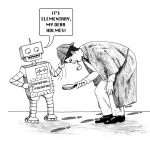Boomtown, New Scientist, 26 May 2007, 48-51.
Ever since Frank Lloyd Wright, people have compared cities to living organisms. Turns out they’re not like living creatures in one important way: as cities get bigger, their pace of life speeds up. This has troubling implications for sustainable growth, because it seems to imply mathematically that cities must go through boom and bust cycles.
Whose Gift is it Anyway? New Scientist, 24-31 December 2005.
For the holiday issue, I took a look at gift cards, a hugely popular marketing tool in America that was just beginning to establish a foothold in England. The trouble with gift cards is the fine print: cards that expire after a certain time, or that have hidden fees. Some US states have banned these practices, but in the UK it was still very much “Recipient beware.”
Soft Cash, NewScientist, 23 July 2005.
Frequent-flier miles. Loyalty cards. Subway cards that can be used to buy coffee, too. Cell phones that can pay for concert tickets. The line between cash and other forms of payment is fast becoming blurred. Some economists have predicted the “death of cash” for years. It probably won’t happen, but it does seem that many parallel “currencies” are emerging that will exist alongside the previously monolithic dollar (or pound sterling).
Ahead of Its Time? Smithsonian, January 2005, 26-28.
New Philadelphia, a town on the Illinois prairie, prospered from 1836 to about 1870, when the railroad passed it by. Frank McWorter, the first black man ever to found a town legally in America, used the proceeds from land sales to buy his family out of slavery. Archaeologists are now excavating New Philadelphia’s remains, and hope to learn how blacks and whites lived together in one of America’s most racially mixed pre-Civil War communities.
Plurality Rules. Swarthmore College Bulletin, September 2004, 17-19.
Learn about instant runoff voting, a way of choosing a winner in multi-candidate elections that gives minority groups a better chance to make their voices heard, according to Swarthmore alumna Cynthia Terrell. Also in the same issue, read my article Voting Power, which explains how to find the “right” number of at-large seats for a city council or any representative body, according to Swarthmore alumnus and mathematician/lawyer Paul Edelman.
Hacking the Ballot Box, Discover, May 2004, 22-23.
When you cast your ballot, will your vote really go to the candidate you intended it to? If you’re voting on an electronic voting machine with no paper trail, you’re taking your chances.
May the Best Man Lose, Discover, November 2000, 84-91.
My semi-prophetic piece about why the most popular candidate doesn’t necessarily win an election. It has nothing to do with hanging chads, but with the vagaries of plurality-based elections. Find out why John McCain might have won in 2000 if we had a different election system!
Making Sense Out of Consensus. SIAM News, October 2000.
Another article about the mathematics of elections. This one focuses especially on the work of Don Saari (University of California, Irvine) and assumes a little bit more mathematical background.
Beautiful Mind‘s Math Guru Makes Truth = Beauty. Science, 1 February 2002, 789-791.
A profile of Dave Bayer, who was responsible for making sure the math in the Oscar-winning movie would pass mathematicians’ sniff test. A slightly condensed version of the article appeared in the Swarthmore College Bulletin, June 2002. (Bayer and I both studied at Swarthmore and took one class together.)
Exploring Origami, Exploratorium, Summer 1999, 20-24.
The Exploratorium did a fantastic job of Web-ifying this article that was originally written for print. See Jeremy Shafer fold a paper crane while the paper is on fire! See his “flasher” hat that can instantly expand to two feet wide or collapse so that it can fit into your pocket! Also see a gallery of other fascinating and unusual origami creations, with some helpful explanatory text by yours truly.







